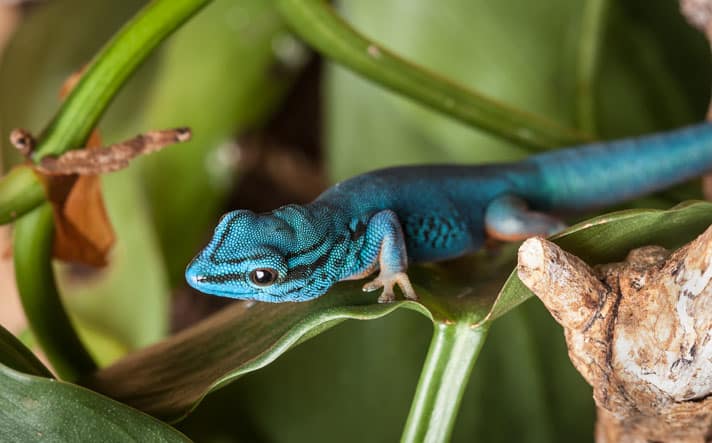In the wild, Lygodactylus williamsi inhabits a very restricted habitat within a limited range. It is critically endangered.
The electric blue gecko (Lygodactylus williamsi, also known as the turquoise dwarf gecko and William’s dwarf gecko) is one of the most distinctive, strikingly colored and sought after geckos in the reptile-keeping hobby. One look at the stunning coloration of a healthy specimen is enough to know why.
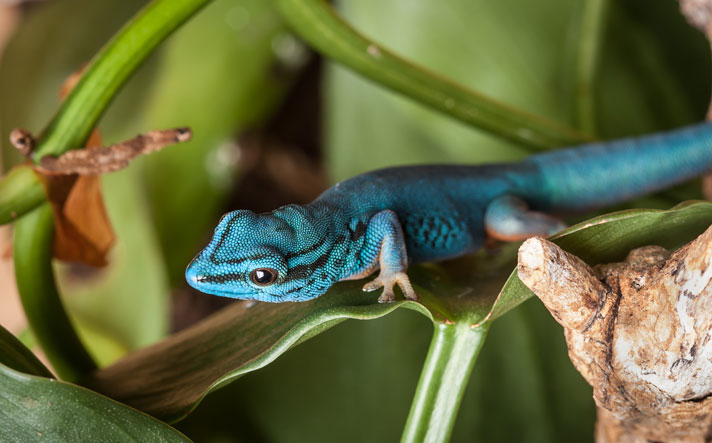
Kika Mika/shutterstock
In the wild, Lygodactylus williamsi inhabits a very restricted habitat within a limited range. It is critically endangered.
The geographic range of the electric blue gecko is comprised of only a few square miles in Tanzania, where its native habitat is similarly restricted to a single species of Pandanus, a genus of palm-like trees. The species’ limited range, along with deforestation and over-collection for the pet trade, has resulted in the electric blue gecko becoming critically endangered, and this year it was classified as an Appendix I species on CITES.
Collecting this beautiful gecko from the wild is prohibited, making captive-bred individuals the only ones that are legally available in the hobby. Luckily, captive-bred L. williamsi are relatively hardy and prolific as long as the captive care needs described in this article are met.
Electric Blue Gecko Description and Sex Determination
Lygodactylus williamsi is a smaller species of gecko, with a total length of about 31/2 inches. It exhibits pronounced sexual dimorphism (meaning the sexes look different), and dominant adult males display the brilliant blue color for which this species is famous. Adult females are typically a greenish, coppery color, or sometimes aqua. Adult males will almost always have a jet black throat region. Females tend to lack black coloration on their throats, or they may display only minimal black striping. Both sexes often have black striping around the eyes and snout, and this is often more pronounced in adult males. Juveniles all look the same regardless of sex, exhibiting the same greenish coloration of the adult females.

David Pegzlz/shutterstock
Electric blue geckos will readily breed in captivity, but hatching the eggs and raising young can be difficult.
Ironically, one of the most challenging aspects of breeding electric blue geckos is determining their gender. Only sexually mature, dominant males display the vivid blue color. This means that if two males are kept together, the subordinate one will remain colored like a female.
Besides seeing the bright blue skin of a dominant male, or witnessing mating or egg laying, the only way to determine the gender of L. williamsi is by examining the preanal pores. Look for approximately eight scales that form a “V” before the cloaca; this “V” in females will barely be visible, and it will be flattened and level with the rest of the ventral scales. In males, however, the “V” will be more obvious.
Electric Blue Gecko Enclosure Tips
Being small in size, electric blue geckos have modest housing requirements. I keep my breeding pairs in 16-inch-cubes. I also house geckos in 19-inch-tall, 16-inch-deep and16-inch-long enclosures. I house single male/female pairs together; multiple males, as well as females, may get territorial and chase each other when kept together.
The enclosures that I prefer are made of high-density plastic, and while these are not as common in the pet trade as commercially produced glass terrariums, there are a number of U.S. manufacturers that build them (including PMHerps and D.W. Geckos & Terraria). They are made of PVC panels that have been chemically welded together, with Plexiglas front-opening doors.
The tops are mostly screening, to allow for ventilation as well as penetration of UVB light and heat from the lamps placed over it. I have heard of many L. williamsi keepers who tried to keep these geckos as you would dart frogs, and the animals always eventually died. The sides of the enclosures feature ventilation holes to aid in the chimney effect which increases fresh air flow into the terraria.
While PVC enclosure such as these are the type I prefer to use, the more commonly available front-opening glass terrariums found for sale in many pet stores are also well suited for keeping electric blue geckos.
Electric Blue Gecko Bioactive Terrariums
The enclosure information that follows applies to my 16-inch enclosures, though can also be adjusted for use with larger display enclosures; just remember these geckos can be quite territorial if you’re thinking of keeping them in groups. The geckos will thrive in either the following more naturalistic seteup or a more basic one as long as all of their basic requirements are met, but keep in mind that L. williamsi are definitely “look, but don’t touch” animals, so maintaining them in a beautifully planted enclosure adds to the enjoyment of keeping them.

frank payne
This is one of the author’s bioactive L. williamsi terrariums.
I like to set up my electric blue geckos in “bioactive” terrariums. To do so, you first need to create a drainage layer in the bottom of the terrarium where excess water can collect. I use an inch of pea gravel covered with landscaping cloth to separate the drainage layer from the substrate layer that will be placed on top of it. Next, add at least 2 to 3 inches of a substrate layer that will hold up well to moist conditions over time. I use a simple, cost-effective mixture of 75-percent peat moss and 25-percent sand. Lastly, a 1-inch layer of leaf litter is placed on top of the substrate. Not only does this look natural, the leaves provide shelter for springtails and other terrarium cleaners. Live plants are planted in the substrate, too; my favorite for electric blue gecko enclosures are wide-leafed Sanseveria plants.
Lygodactylus williamsi are arboreal and need perches to move throughout their environment. I cut dried bamboo to the exact lengths I need and position the sections in the enclosure with some horizontal, vertical and diagonal, and at different heights. By doing this, you will allow the geckos to choose the exact temperature in which they wish to be at any given time.
Electric Blue Gecko Light and Temperature Requirements
Because the electric blue gecko is a diurnal species, meaning it’s active during thd day, bright light of the proper UVB spectrum needs to be provided. I keep my enclosures in a rack that is 48 inches long, and I use a 48-inch-long dual fluorescent shoplights over each row of enclosures. One bulb is a 6500K bulb, which provides nice, white light and is very beneficial to both the plants and the geckos, while the other bulb is a UVB-producing bulb. I use Zoo Med 10.0 bulbs and Arcadia 6.0 bulbs to provide UVB.

frank payne
This is a mating pair of the author’s L. williamsi.
The electric blue gecko’s natural habitat is in a tropical climate, and pet geckos require fairly warm temperatures. As with all captive reptiles, thermal gradients are the key to success. You must provide a variety of suitable temperatures from which the geckos can choose. A basking spot provided by a heat lamp is necessary. I use a halogen puck light plugged into a dimmer switch, which allows me to very precisely control the amount of heat produced by the bulb in order to achieve the desired temperature.
For a thermal gradient, I aim for a localized basking spot of 90 to 95 degrees Fahrenheit. The uppermost portion of the terrarium is kept at 80 to 85 degrees and 75 to 80 degrees toward the bottom. A nighttime drop is natural and easily accomplished just by turning off heat and lights at night, and temperatures as low as 60 degrees are fine at night. Heat and lights should be plugged into a timer. Mine are on for 14 hours during the peak of summer, 10 hours during winter, and 12 hours during fall and spring.
Electric Blue Gecko Misting and Humidity
To provide your geckos with adequate humidity and drinking water you will need some way to mist the terrarium (a water bowl is not recommended). This can be as easy and cheap as a hand mister or as complex as an automated misting system. If you only have one or two terrariums you could get away with hand misting, but I think an automated misting system is one of the best investments you can make.
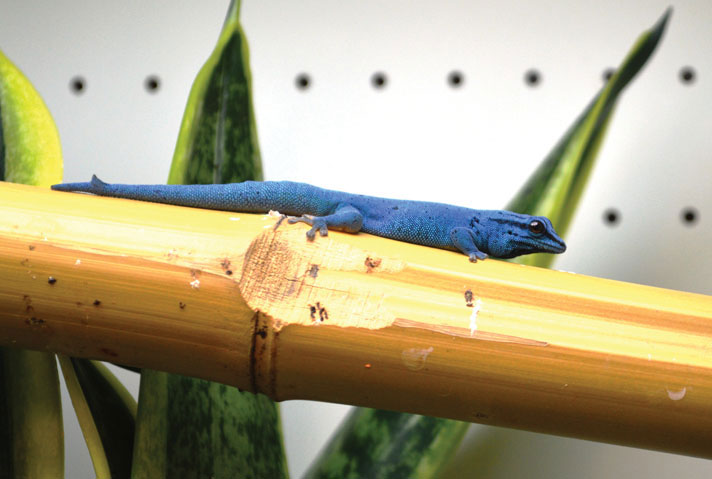
frank payne
The electric blue gecko’s natural habitat is in a tropical climate, and pet geckos require fairly warm temperatures.
I mist my L. williamsi enclosures two to three times a day for approximately one minute each session. Misting routines will need to be adjusted for every enclosure and environment, but the goal is to thoroughly cover the leaves of the plants and the sides of the terrarium with water droplets, and then stop before the soil in the bottom becomes overly saturated.
It is important not to mist the enclosure again until all the water droplets have evaporated and the topmost layer of the soil/leaf litter has started to dry out. It may take time and practice to find the proper misting schedule for your own enclosures.
A common mistake with electric blue geckos is keeping them too wet. In the wild, they live out in the open, on trees that are dry for much of the day. In the small enclosures where pet geckos are often kept, it’s easy to go overboard with the misting, but if you follow the previous instructions, you should be fine.
Electric Blue Gecko Diet and Calcium
The way I feed my electric blue geckos often surprises new keepers. Ninety-percent of my geckos’ diet is the powdered diets made for geckos. I use the Pangea Complete formula, and I buy a different flavor every time I need more. I put the food in bottle caps, which I then Velcro to elevated perches. My young geckos always have a capful of Pangea Complete in their enclosures, and adults are fed every two to three days to prevent obesity.
Occasionally I will also offer live insects, such as fruit flies, bean beetles, and 1⁄8-inch crickets that are dusted with Repashy Calcium Plus or Miner All Indoor.
With this diet and the previously described care, my electric blue geckos grow quickly, reaching full size and sexual maturity at around 4 to 5 months old, productive breeding results, as well.
Breeding Electric Blue Geckos
Getting L. williamsi to breed is pretty simple. If you keep an adult male and an adult female together, odds are they will breed and lay eggs. However, getting those eggs to hatch and then raise the offspring to maturity can be more difficult.
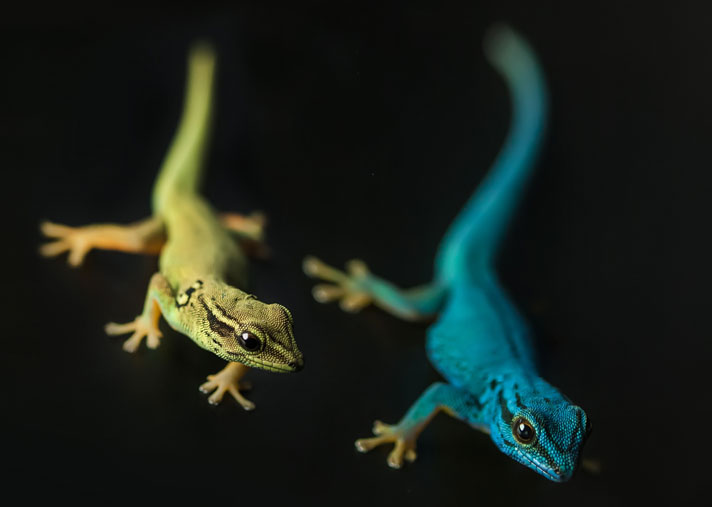
Kika Mika/shutterstock
This pair of electric blue geckos shows the difference between the females (left) and males.
One crucial aspect to consider prior to breeding is the health of the female. Female electric blue geckos often will produce a pair of eggs every two to three weeks, and this fast pace puts a huge strain on their bodies. The key is to keep your geckos in peak health from the beginning. This means maintaining them at a proper weight and ensuring the females get enough calcium.
This does not mean feeding the geckos as much as they will eat; doing so can lead to health problems in adult animals, especially females. As for calcium, it’s impossible to provide female L. williamsi with enough calcium through food alone. All their enclosures, especially those housing breeding females, need to include a small container of pure calcium powder. I use bottle caps filled with Repashy SuperCal NoD. The females, and possibly males, too, will consume enough powdered calcium to meet their requirements. I change out the calcium powder about every two weeks. Keep it away from water as it hardens once it becomes wet. Without a proper diet and additional calcium for breeding females they will likely experience a reduced lifespan, as well as increased hatchling mortality.
Electric blue geckos are “egg gluers.” This means that when a female lays her clutch they dry and attach very quickly to the surface upon which they were laid. Once they have been “glued” in this fashion, it is basically impossible to remove the eggs from that surface without destroying them.
Unless females are provided with specific nesting sites they will often lay eggs on the terrarium walls. They instinctively prefer tight spaces, too, so any gaps and crevices in the terrarium may be used as egg-laying sites.
You may be tempted to leave the eggs where they are laid to hatch, but doing so may result in problems. First, once the eggs hatch, the young will often be quickly eaten by their parents! Eggs left in the terrarium are also subject to the environmental conditions at the particular spot in which they were laid. This is a problem because L. williamsi are subject to TSD (temperature sex determination), and eggs are often laid high up in the terrarium where temperatures are warmer. This is why there are so many more male electric blue geckos available for purchase than females.
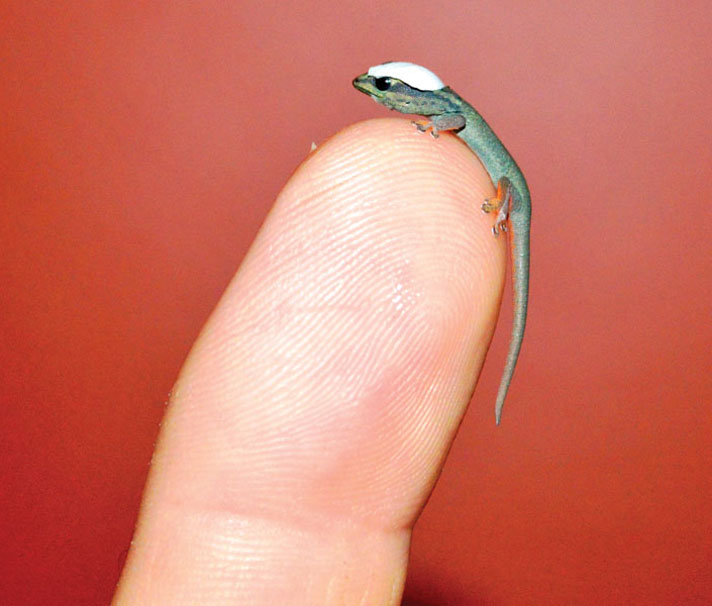
frank payne
A freshly emerged hatchling electric blue gecko with an eggshell cap.
The key to getting around these problems is to provide appealing egg-laying sites that can be removed from the terrarium and incubated under controlled conditions. I use opaque floral water tubes — the type used by florists — attached horizontally to the upper sides of the terrarium using Velcro. Once they contain eggs, I move both tube and eggs to an incubation container.
Good ventilation and high humidity are both needed during incubation. I accomplish this by placing the water tubes on top of a layer of saturated Repashy SuperHatch in a plastic container, with air holes punched into the lid. There should be enough holes to prevent constant condensation inside the container, but not so many that the humidity escapes. Take care, too, that the holes are very small so newly hatched geckos don’t escape.
As mentioned, the sex of electric blue geckos is determined by the temperature at which the eggs are incubated. Average daily temperatures of 70 to 76 degrees will produce females, 78 to 81 degrees results in both males and females, and temperatures of 83 degrees and above will yield males. These are not meant to be constant temperatures, but rather day time averages.
A nighttime drop in temperature should occur; I let it go down to 70 degrees.
Instead of placing the egg container in an incubator, I place it in an area of my reptile room that maintains the proper temperatures. Hatching can occur after 60 to 120 days, depending on temperature.
As long as the breeding females have been well taken care of and the eggs incubated correctly, rearing of the hatchlings is not too difficult. I keep them exactly like the adults, except in slightly smaller enclosures. Just be sure that there are no gaps through which they can escape, as hatchling electric blue geckos give new meaning to the word small!
The Electric Blue Gecko
Of all the reptiles I have kept and bred, I am most passionate about these little geckos. They are some of the most beautiful, behaviorally interesting, and initially challenging animals that I have worked with. Due to their limited range and low numbers in the wild, these critically endangered living jewels deserve our attention in the hobby.
Luckily, when properly cared for L. williamsi can be highly prolific in captivity. Everything about these geckos is fast paced, allowing the new keeper to go from novice to breeder in a short amount of time. I do hope that my experiences and the care regimen provided in this article will prove useful to new keepers and that the beautiful electric blue gecko becomes further well established in herpetoculture.
Frank J. Payne is a biology teacher, former senior herpetology keeper and private reptile breeder. He has been keeping and breeding reptiles personally for over 20 years. As a senior AZA herpetology keeper, he worked with more than 100 species of reptiles and amphibians, many of which were threatened or endangered. As a zookeeper, he traveled the country with live animal exhibits, and he often appeared on television shows, including “Late Show with David Letterman.” Visit him online at livingartbyfrankpayne.com.

